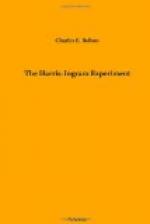Christine, who was about Alfonso’s age, had fair complexion, light hair, and soft blue eyes. Her beauty added refinement that education and wide travel usually furnish.
It was seen in Alfonso’s face and in his marked deference that Christine filled his ideal of a beautiful woman. Christine and her mother and the young artists were registered at the Hotel de Orange, so of necessity they were thrown into each other’s company. They drove to The Hague, compared the statues of William of Orange with each other; rode along the elegant streets, south through the Zoological and Botanical Gardens, through the park, and to the drill grounds. A half-day was spent in visiting the “House in the Woods,” a Royal Villa, one and one-half miles northeast of The Hague. This palace is beautifully decorated, particularly the Orange Salon, which was painted by artists of the school of Rubens.
Alfonso and Leo enjoyed their visits to the celebrated picture gallery, which contains among many Dutch paintings the famous pictures by Paul Potter and Rembrandt. Paul Potter’s Bull is deservedly popular. This picture was once carried off to Paris, and there ranked high in the Louvre, and later the Dutch offered 60,000 florins to Napoleon for its restoration.
Christine, who was well conversant with art matters, knew the location and artistic value of each painting and guided the young Americans to works by Van Dyck, Rubens, the Tenniers, Holbein, and others. She was proud of a terra-cotta head of her ancestor, Admiral de Ruyter. The party soon reached Rembrandt’s celebrated “School of Anatomy,” originally painted for the Amsterdam Guild of Surgeons. Tulp is in black coat with lace collar and broad-brimmed soft hat, dissecting a sinew of the arm of the corpse before him. He is explaining, with gesture of his left hand, his theory to a group of Amsterdam surgeons. No painter ever before succeeded in so riveting the attention of spectators in the presence of death. The listeners appear altogether unconscious of the pallid corpse that lies before them on the dissecting table.
Invited by Christine’s mother, the young artists accompanied the De Ruyters to Amsterdam, the commercial capital of Holland, with 300,000 inhabitants. They live on ninety islands formed by intersecting canals, which are crossed by three hundred bridges. The buildings rest on foundations of piles, or trees, which fact gave rise to Erasmus’s jest, that he knew a city where the people dwelt on tops of trees, like rooks.
Alfonso took Leo into the suburbs to see diamond polishing. The machinery is run by steam, and the work is done largely by Portuguese Jews. These precious stones are cut or sawed through by means of wires covered with diamond dust, and the gems are polished by holding them against rapidly revolving iron disks moistened with a mixture of diamond dust and oil.




